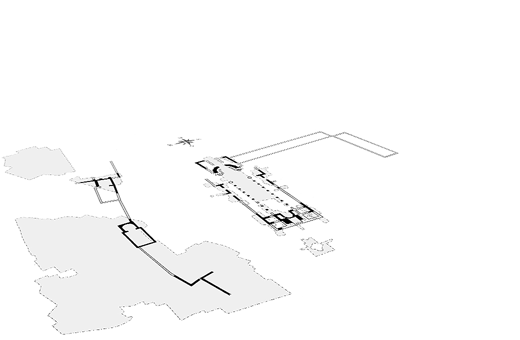- Home
- The town and the abbey
- From the royal abbey to the castellum
- The castellum from 869 to the early 11th century
Reconstructed view of the monumental complex: 11th century.
© Ministère de la culture / M. Wyss ; A.-B. Pimpaud ; M.-O. Agnes.
Layout of the monumental ensemble: 11th century.
© Ministère de la culture / M. Wyss ; A.-B. Pimpaud ; M.-O. Agnes.
The abbey protects itself
In 869, Charles the Bald ordered the construction of Saint-Denis' first fortification, in order to protect the monastery from Viking raids. We know this not only from written sources, by also via archaeology. The king's decision to entrust the protection of what would become a castellum, to a representative of the military represented a serious intrusion into the spiritual life of the monastery. The monks showed that the rampart had been built on land that had long been theirs, and in 898 their right to immunity was extended to all of the land located within the castellum.
The foundation of a college of canons
Following a reform of the Benedictine abbey, which was entrusted to the abbot Odilon from Cluny by Robert le Pieux (996-1031), a college of canons, - whose members probably came from the community of monks - was established in the Saint Paul church.
The royal presence declines
Over time, within the shelter afforded by its walls, the castellum Sancti Dionysii became a prosperous town. In 1008, the king granted the abbot "la justice du sang", i.e. the right to pass a death sentence within the town and its lands. The abbey thus became a simple seigneury, with the power to make decisions on military, fiscal, legal and economic matters.. With this, the monks became rivals of the lords of Montmorency, whose castellany stood at the gates of the castellum on the "land of Saint Marcel". At the same time, the king renounced his thrice-yearly visits to Saint-Denis, where he held court on the occasion of the major religious festivals. He restored the domus - his residence near the basilica - to the monks, together with all of its outbuildings.
The buildings of the palace gradually disappeared, leaving room for an extension of both secular housing and the cemetery. The funerary churches underwent extensive architectural modifications, no doubt in connection with their new status as parish churches. The galleries that connected them were demolished and replaced with walls that, together with the churches, formed a boundary around which dwellings began to be built.
Outlying housing clusters
Additional areas of habitation developed on the outskirts of the castellum, due to the presence of either a church or a road. In Saint-Marcel, the cemetery is brought closer to the parish church, built at some distance from the Merovingian necropolis. Next to the Saint-Martin church, the abbey founded the Saint-Denis-de-l'Estrée priory. in the eleventh century, this priory-along with the Saint-Remi and Saint-Quentin churches-would serve as a reference point to mark the abbey's territory, a space exempt from the authority of the Bishop of Paris.


